Stress Intensity Factor Assessment for the Reinforcement of Cracked Steel Plates Using Prestressed or Non-Prestressed Adhesively Bonded CFRP
Abstract
1. Introduction
2. Summary of the Experimental Studies on CFRP-Reinforced Cracked Steel Plates
3. Assessment of Modified Stress Intensity Factor for Repaired Steel Plate
3.1. Stress Intensity Factor (SIF) of Un-Repaired Specimens (Reference Ones)
3.2. Determination of the Modified Stress Intensity Factor (SIF) Using Semi-Empirical Analysis
- 1.
- First, the Paris law parameters, C and m (which only depends on the material properties) are determined from a fatigue test on the reference specimens (index R, see Equation (6)):where corresponds to the crack length measured at mid-thickness of the plate (maximum crack length), corresponds to the number of cycles, and is the SIF range at crack tip obtained from the classical solution previously given.From the experimental results, values of 9.86 × 10−14 and 3.04 (∆K in MPa.mm1/2 and da/dN in mm/cycle) were respectively obtained for and .
- 2.
- Then, from the fatigue tests on the CFRP-reinforced specimens (index CFRP), the crack growth rate is determined (see Equation (7)):For double-sided repaired specimens, the crack length corresponds to the measure at mid-thickness of the plate, while for single-sided specimens, the crack length corresponds to the measure at the un-patched surface of the plate (maximum crack length).
- 3.
- Finally, the Paris law is used for the CFRP-reinforced specimens (considering the same parameters, C and m), which allows determining the modified SIF, (ΔK)CFRP, for each reinforcement configuration (see Equation (8)):
3.3. Determination of the Modified Stress Intensity Factor (SIF) Using Finite Element Model
4. Results
4.1. Validation of the Model
4.2. Reinforced Specimens
4.2.1. Distribution of the Stress Intensity Factor (SIF)
4.2.2. Determination of the SIF Value for Each Crack Length
- the maximum value of SIF along the crack front (K_max);
- the average of all values along the crack front (K_avg);
- the mid-point value in thickness (K_mid);
- the average of values from mid-point to patched side (K_mp);
- the average of values from mid-point to un-patched side (K_mup).
4.3. Parametric Analysis—Pre-Stressing Level
5. Conclusions
- Good fitting was observed between experimental and numerical results. The proposed FEM can thus be successfully used in order to evaluate the fatigue behavior of repaired cracked steel plate by CFRP bonding.
- Single-sided CFRP reinforcement led to a non-uniform distribution of the SIF along the crack front. A substantial decrease of SIF was observed immediately under the patched surface, and even more for specimens reinforced by UHM CFRP laminate and pre-stressed NM CFRP laminate. Therefore, for this reinforcement configuration, it appears essential to identify the adequate SIF value to consider for each crack front. Comparison between experimental and numerical results showed that the use of the SIF value at mid-thickness of the plate allows a good assessment of the fatigue life.
- Double-sided reinforced specimens exhibited a uniform distribution of the SIF along the crack front, resulting in a better increase in fatigue lifetime compared to single-sided reinforced specimens. For this reinforcement configuration, the average value of SIF, for each crack front, can be used to assess the fatigue life.
- By considering the reduction factor FCFRP in the closed-form solution of SIF, the mode-I SIF for CFRP-repaired specimens can be obtained, taking into account both the effects of the mechanical properties of CFRP laminates (CFRP modulus, application of pre-stressing force) and the reinforcement geometry (single-sided or double-sided bonding).
- The parametric study regarding the effect of pre-stressing level for single-sided reinforced specimens showed that a higher pre-stressing level led to a greater reduction in SIF directly under the patched surface. A bigger compressive stress zone through thickness was also observed for higher pre-stressing level but remained limited by the un-symmetrical configuration (secondary bending).
Author Contributions
Funding
Institutional Review Board Statement
Informed Consent Statement
Data Availability Statement
Acknowledgments
Conflicts of Interest
References
- Zhao, X.L.; Zhang, L. State-of-the-art review on FRP strengthened steel structures. Eng. Struct. 2007, 29, 1808–1823. [Google Scholar] [CrossRef]
- Jones, S.C.; Civjan, S.A. Application of fiber reinforced polymer overlays to extend steel fatigue life. J. Compos. Constr. 2003, 7, 331–338. [Google Scholar] [CrossRef]
- Liu, H.; Al-Mahaidi, R.; Zhao, X.L. Experimental study of fatigue crack growth behaviour in adhesively reinforced steel structures. Compos. Struct. 2009, 90, 12–20. [Google Scholar] [CrossRef]
- Wu, C.; Zhao, X.L.; Al-Mahaidi, R.; Duan, W.H. Mode I stress intensity factor of center-cracked tensile steel plates with CFRP reinforcement. Int. J. Struct. Stab. Dyn. 2013, 13, 1350005. [Google Scholar] [CrossRef]
- Yu, Q.Q.; Zhao, X.L.; Chen, T.; Gu, X.L.; Xiao, Z.G. Crack propagation prediction of CFRP retrofitted steel plates with different degrees of damage using BEM. Thin-Walled Struct. 2014, 82, 145–158. [Google Scholar] [CrossRef]
- Colombi, P.; Fava, G.; Sonzogni, L. Fatigue crack growth in CFRP-strengthened steel plates. Compos. Part B 2015, 72, 87–96. [Google Scholar] [CrossRef]
- Aljabar, N.J.; Zhao, X.L.; Al-Mahaidi, R.; Ghafoori, E.; Motavalli, M.; Koay, Y.C. Fatigue tests on UHM-CFRP strengthened steel plates with central inclined cracks under different damage level. Compos. Struct. 2017, 160, 995–1006. [Google Scholar] [CrossRef]
- Wang, H.T.; Wu, G.; Jiang, J.B. Fatigue behavior of cracked steel plates strengthened with different CFRP systems and configurations. J. Compos. Constr. 2016, 20, 04015078. [Google Scholar] [CrossRef]
- Bassetti, A.; Nussbaumer, A.; Hirt, A. Fatigue life extension of riveted bridge members using prestressed carbon fibre composites. 2000. Available online: https://infoscience.epfl.ch/record/115900 (accessed on 24 February 2021).
- Colombi, P.; Bassetti, A.; Nussbaumer, A. Analysis of cracked steel members reinforced by pre-stress composite patch. Fatigue Fract. Eng. Mater. Struct. 2003, 26, 59–66. [Google Scholar] [CrossRef]
- Täljsten, B.; Hansen, C.S.; Schmidt, J.W. Strengthening of old metallic structures in fatigue with prestressed and non-prestressed CFRP laminate. Constr. Build. Mater. 2009, 23, 1665–1677. [Google Scholar] [CrossRef]
- Huawen, Y.; König, C.; Ummenhofer, T.; Shizhong, Q.; Plum, R. Fatigue performance of tension steel plates strengthened with prestressed CFRP laminates. J. Compos. Constr. 2010, 14, 609–615. [Google Scholar] [CrossRef]
- Emdad, R.; Al-Mahaidi, R. Effect of prestressed CFRP patches on crack growth of Centre-notched steel plates. Compos. Struct. 2015, 123, 109–122. [Google Scholar] [CrossRef]
- Hosseini, A.; Ghafoori, E.; Motavilli, M.; Nussbaumer, A.; Zhao, X.L. Mode I fatigue crack arrest in tensile steel members using prestressed CFRP plates. Compos. Struct. 2017, 178, 119–134. [Google Scholar] [CrossRef]
- Mohajer, M.; Bocciarelli, M.; Colombi, P.; Hosseini, A.; Nussbaumer, A.; Ghafoori, E. Irreversible cyclic cohesive zone model for prediction of mode I fatigue crack growth in CFRP-strengthened steel plates. Theor. Appl. Fract. Mech. 2020, 110, 102804. [Google Scholar] [CrossRef]
- Dong, J.; Li, Z.; Pasternak, H.; Ciupack, Y. Reinforcement of fatigue damaged steel structures using CFRP lamellas-Part 3: Numerical simulation. Bauingenieur 2020, 95, 362–368. [Google Scholar] [CrossRef]
- Ghafoori, E.; Schumacher, A.; Motavalli, M. Fatigue behaviour of notched steel beams reinforced with bonded CFRP plates: Determination of prestressing level for crack arrest. Eng. Struct. 2012, 45, 270–283. [Google Scholar] [CrossRef]
- Ghafoori, E.; Motavalli, M.; Botsis, J.; Herwig, A.; Galli, M. Fatigue strengthening of damaged metallic beams using prestressed unbonded and bonded CFRP plates. Int. J. Fatigue 2012, 44, 303–315. [Google Scholar] [CrossRef]
- Ghafoori, E.; Motavalli, M.; Nussbaumer, A.; Herwig, A.; Prinz, G.S.; Fontana, M. Determination of minimum CFRP pre-stress levels for fatigue crack prevention in retrofitted metallic beams. Eng. Struct. 2015, 84, 29–41. [Google Scholar] [CrossRef]
- Hosseini, A.; Nussbaumer, A.; Motavalli, M.; Zhao, X.L.; Ghafoori, E. Mixed mode I/II fatigue crack arrest in steel members using prestressed CFRP reinforcement. Int. J. Fatigue 2019, 127, 345–361. [Google Scholar] [CrossRef]
- Yin, W.; Fang, Q.; Wang, S.; Wang, X. Fatigue strength of high-strength bolted joints. In Proceedings of the IABSE Colloquium, Lausanne, Switzerland, March 1982; pp. 707–714. [Google Scholar] [CrossRef]
- Wang, H.; Wu, G.; Pang, Y.Y. Theoretical and numerical study on stress intensity factors for FRP-strengthened steel plates with double-edged cracks. Sensors 2018, 18, 2356. [Google Scholar] [CrossRef]
- Mohabeddine, A.; Correia, J.; Montenegro, P.A.; Castro, J.M. Fatigue crack growth modelling for cracked small-scale structural details repaired with CFRP. Thin-Walled Struct. 2021, 161, 107525. [Google Scholar] [CrossRef]
- Lepretre, E.; Chataigner, S.; Dieng, L.; Gaillet, L.; Gagnon, A.; Roth, J.; LeRoy, C. Experimental characterization of different adhesively bonded composite reinforcement processes for old steel structures. In Proceedings of the Structural Faults and Repair, Edinburgh, UK, 17–19 May 2016. [Google Scholar]
- Lepretre, E.; Gagnon, A.; Chataigner, S.; Dieng, L.; Gaillet, L. Reinforcement of old steel structures by CFRP bonding, modified mode I stress intensity factor. In Proceedings of the 8th International Conference on Fibre-Reinforced Polymer (FRP) Composites in Civil Engineering (CICE), Hong Kong, China, 14–16 December 2016. [Google Scholar]
- Lepretre, E.; Chataigner, S.; Dieng, L.; Gaillet, L. Fatigue strengthening of cracked steel plates with CFRP laminates in the case of old steel materials. Constr. Build. Mater. 2018, 174, 421–432. [Google Scholar] [CrossRef]
- Anderson, T.L. Fracture Mechanics: Fundamentals and Applications; Taylor & Francis: Boca Raton, FL, USA, 2005. [Google Scholar]
- Fiordalisi, S. Modélisation Tridimensionnelle de la Fermeture Induite par Plasticité lors de la Propagation D’une Fissure de Fatigue Dans L’acier 304L. ISAE-ENSMA. Ph.D. Thesis, Ecole Nationale Supérieure de Mécanique et d’Aérotechnique, Poitiers, France, 2014. [Google Scholar]
- Branco, R.; Rodrigues, D.M.; Antunes, F.V. Influence of through-thickness crack shape on plasticity induced crack closure. Fatigue Fract. Eng. Mater. Struct. 2008, 31, 209–220. [Google Scholar] [CrossRef]
- Seo, D.C.; Lee, J.J. Fatigue crack growth behavior of cracked aluminum plate repaired with composite patch. Compos. Struct. 2002, 57, 323–330. [Google Scholar] [CrossRef]
- Lee, W.Y.; Lee, J.J. Successive 3D FE analysis technique for characterization of fatigue crack growth behavior in composite repaired aluminum plate. Compos. Struct. 2004, 66, 513–520. [Google Scholar] [CrossRef]
- Boscolo, M.; Zhang, X. A modelling technique for calculating stress intensity factors for structures reinforced by bonded straps. Part I: Mechanisms and formulation. Eng. Fract. Mech. 2010, 77, 883–895. [Google Scholar] [CrossRef]
- Besseghier, E.H.; Djebli, A.; Bendouba, M.; Baltach, A.; Aid, A. A 3D analysis of crack-front shape of asymmetric repaired aluminium panels with composites patches. Fract. Struct. Integr. 2019, 13, 547–556. [Google Scholar]
- Tada, H.; Paris, P.C.; Irwin, G.R. The Stress Analysis of Cracks Handbook. ASME Press: New York, NY, USA, 2000. [Google Scholar]
- Palmberg, B. A stress intensity factor equation for cracks at an open hole in a sheet of finite dimensions subjected to a uniform, uniaxial stress. In Scientific Report FOI-R-0061-SE; Swedish Defense Research Agency: Stockholm, Sweden, 2001. [Google Scholar]
- Bakker, A. Three dimensional constraint effects on stress intensity distributions in plate geometries with through-thickness cracks. Fatigue Fract. Eng. Mater. Struct. 1992, 15, 1051–1069. [Google Scholar] [CrossRef]
- Paris, P.; Erdogan, F. A critical analysis of crack propagation laws. J. Basic Eng. Trans. ASME Ser. D 1963, 85, 528–534. [Google Scholar] [CrossRef]
- James, L.A.; Anderson, W.E. A simple experimental procedure for stress intensity factor calibration. Eng. Fract. Mech. 1969, 1, 565–568. [Google Scholar] [CrossRef]
- Volume A: Theory and User Information; MSC. Software Corporation: Newport Beach, CA, USA, 2013.
- Krueger, R. The virtual crack closure technique: History, approach and applications. Appl. Mech. Rev. 2004, 57, 109–143. [Google Scholar] [CrossRef]
- Duong, C.N.; Wang, C.H. On the characterization of fatigue crack growth in a plate with a single-sided repair. Eng. Mater. Technol. 2004, 126, 192–198. [Google Scholar] [CrossRef]

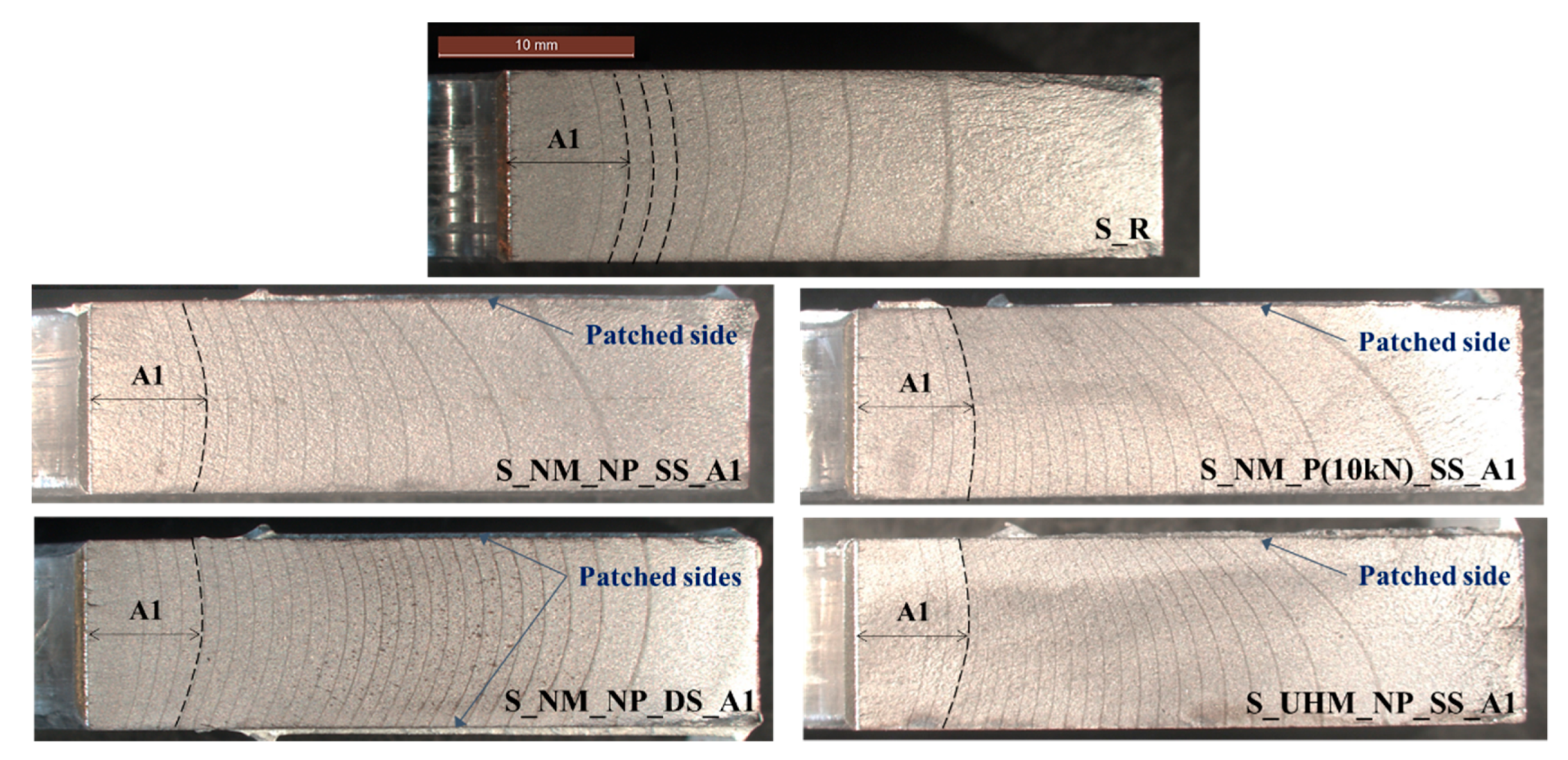
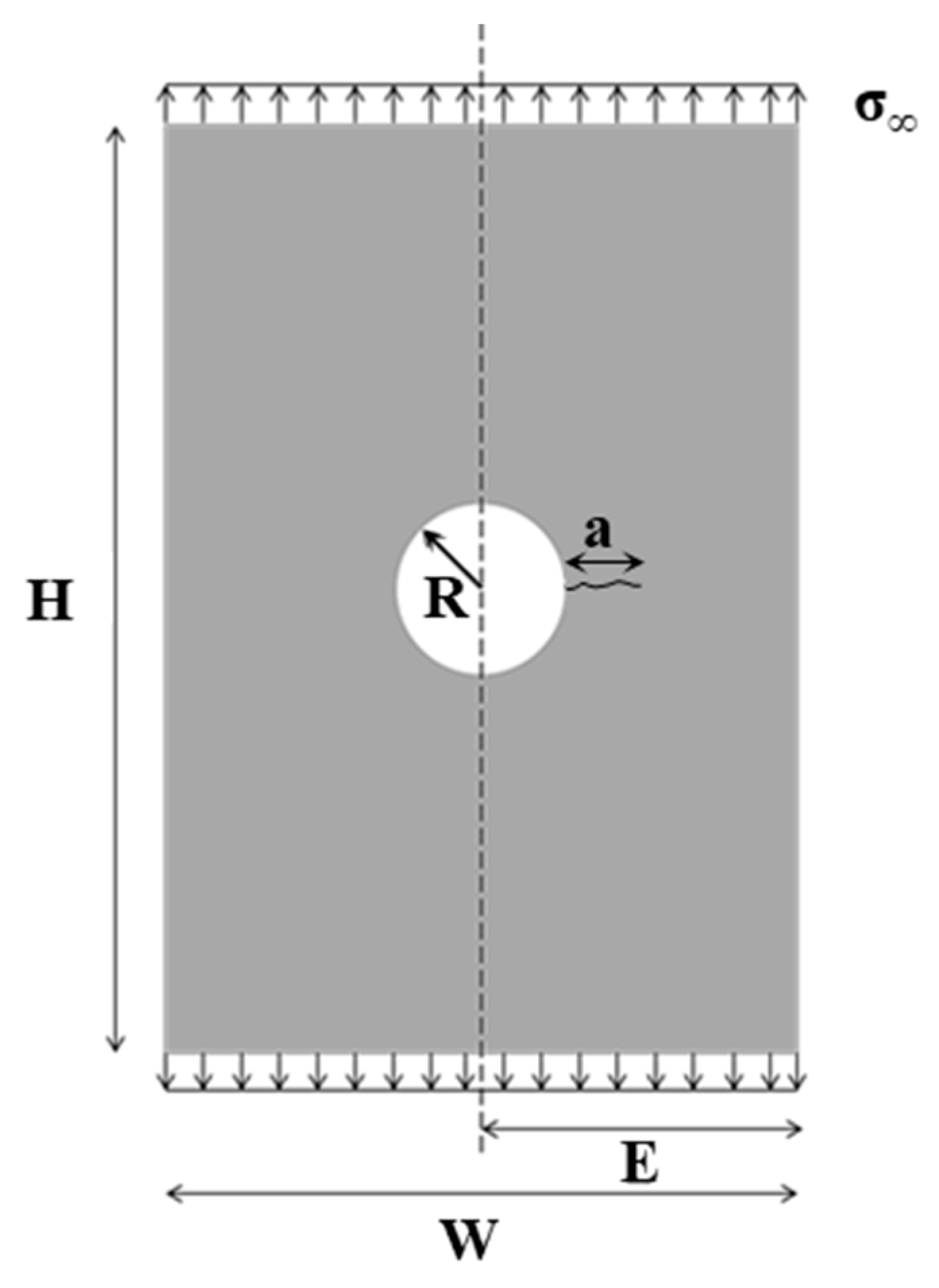

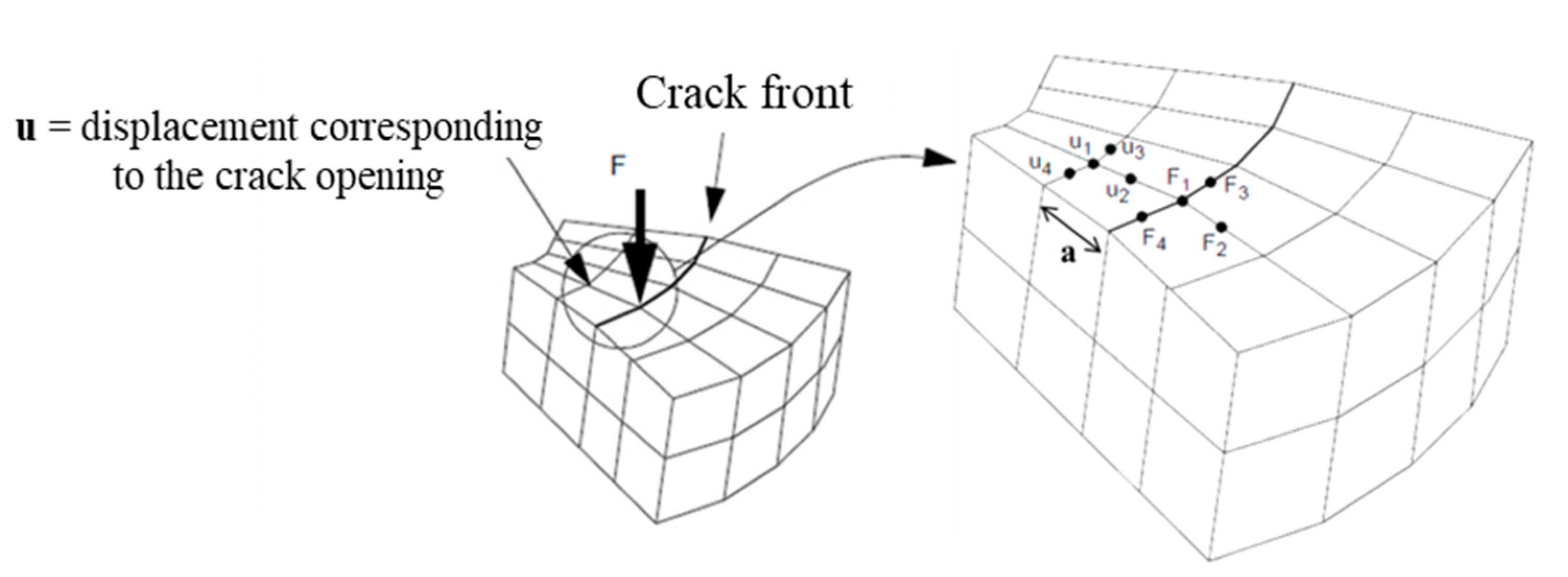


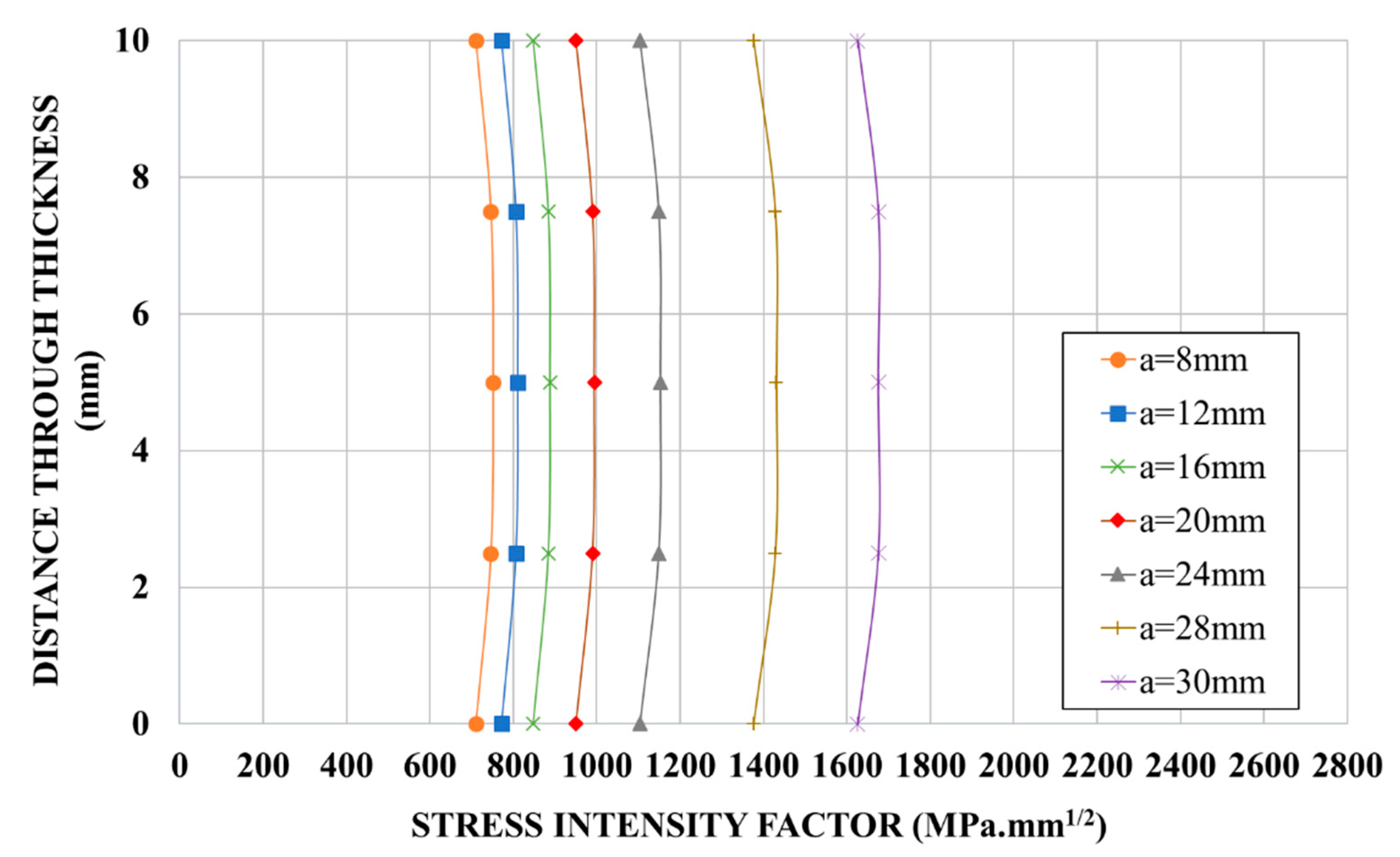
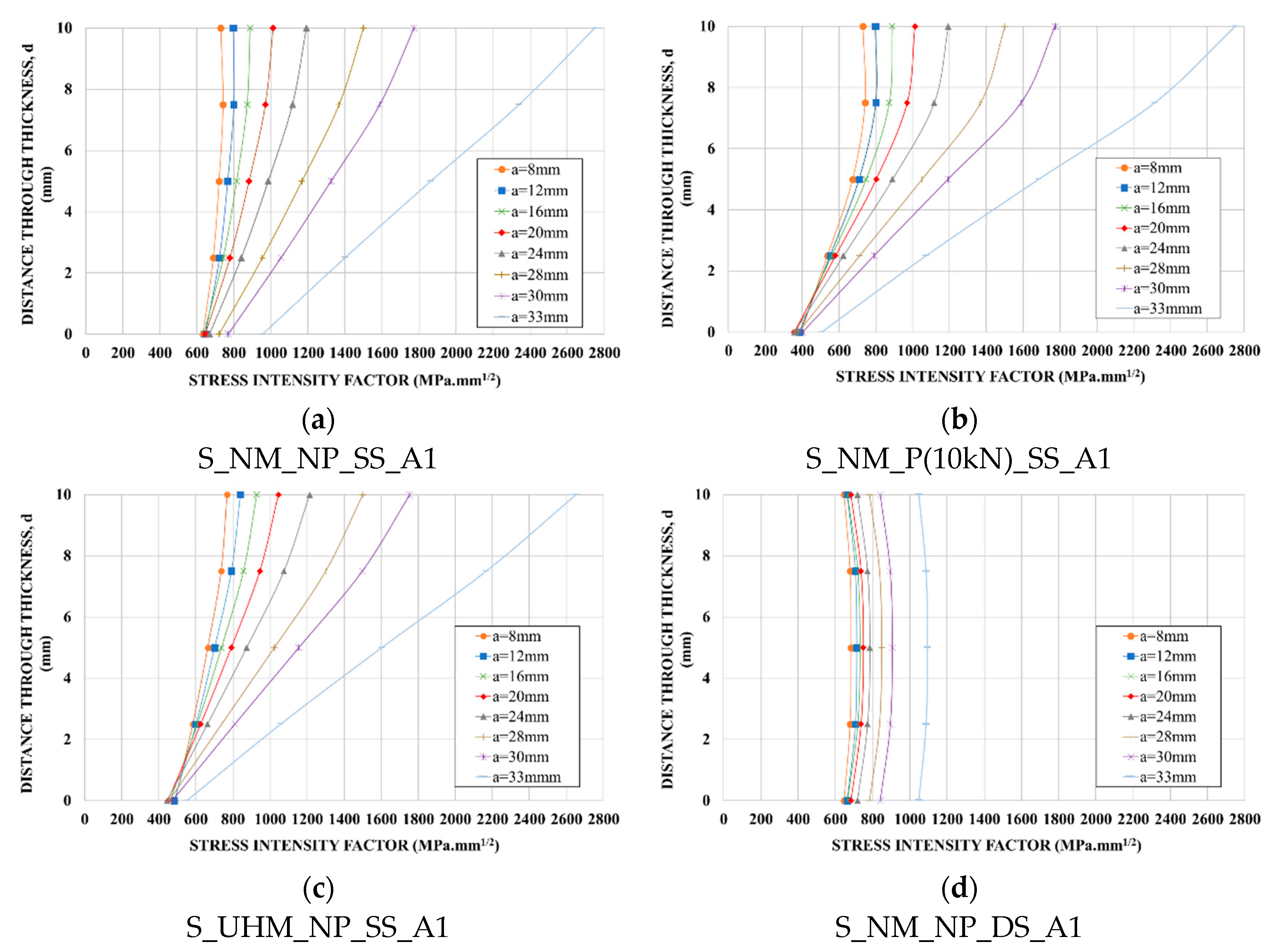

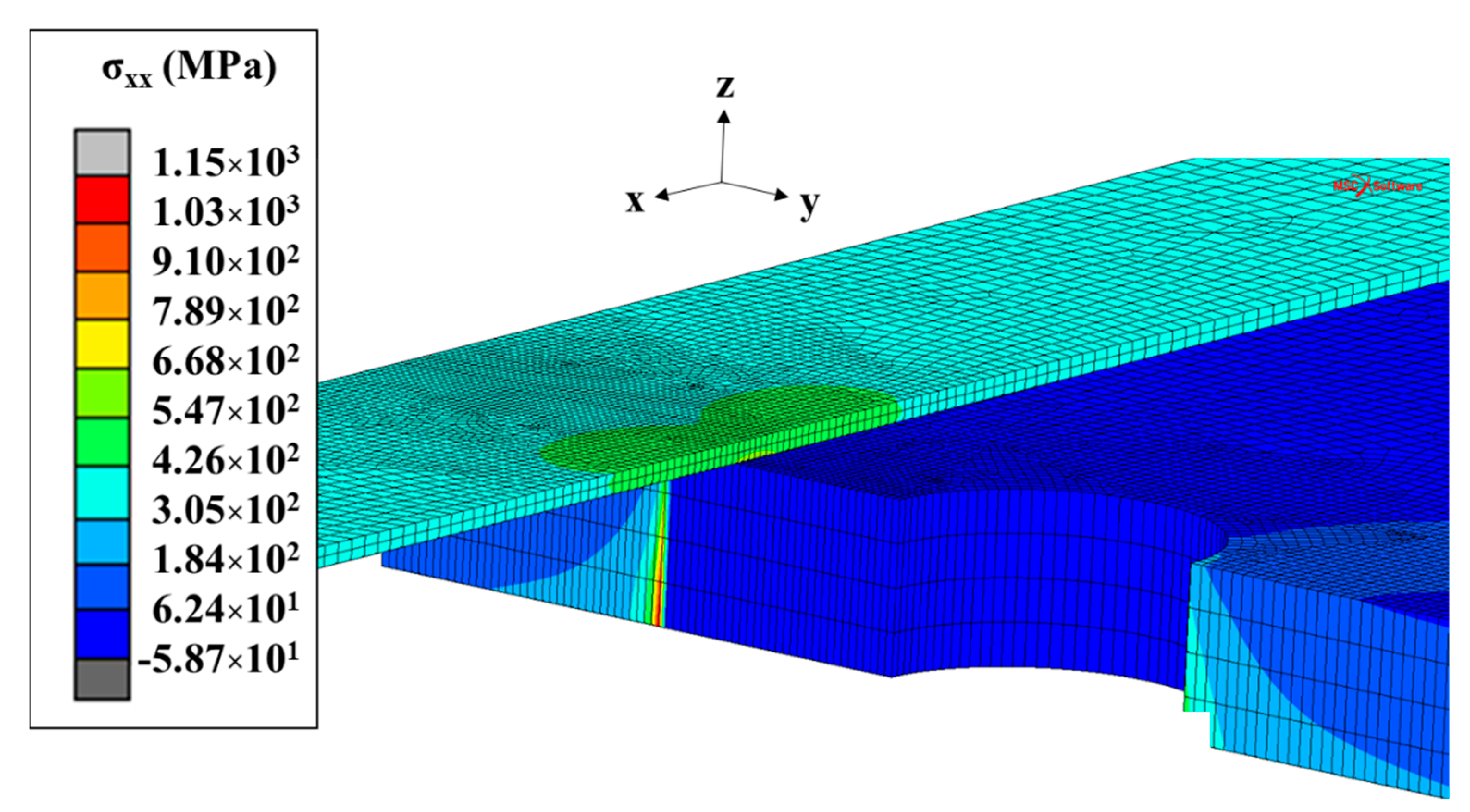
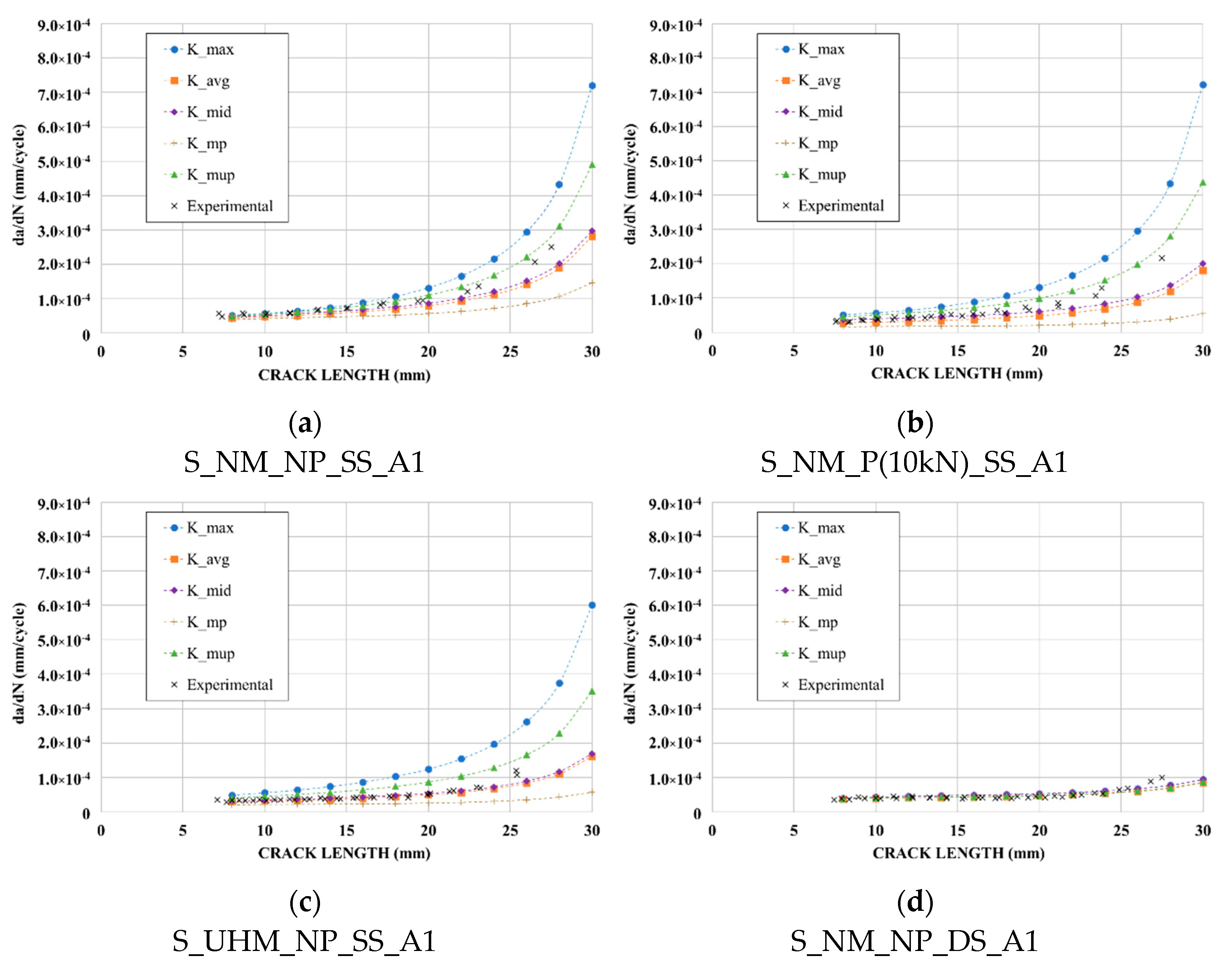

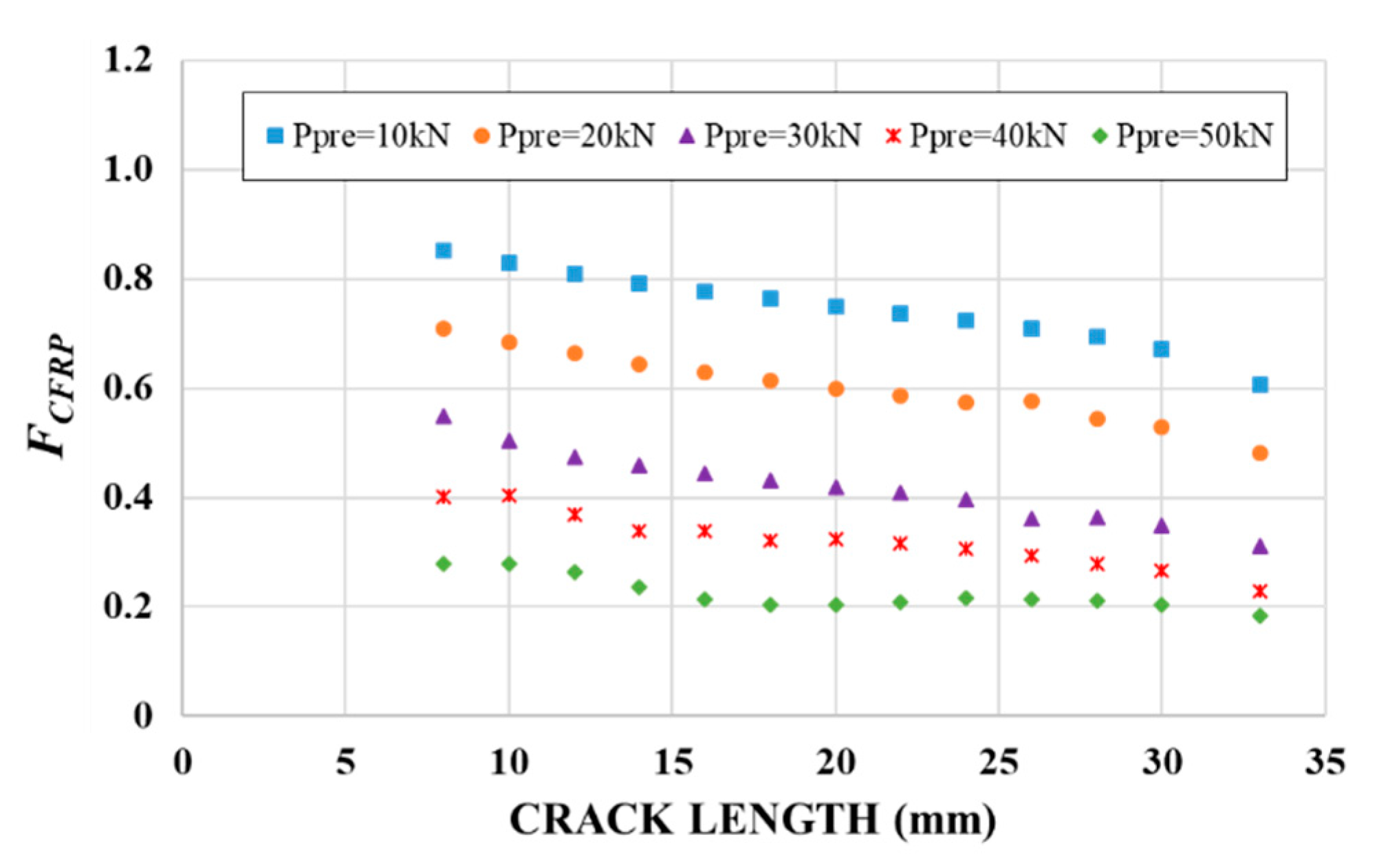
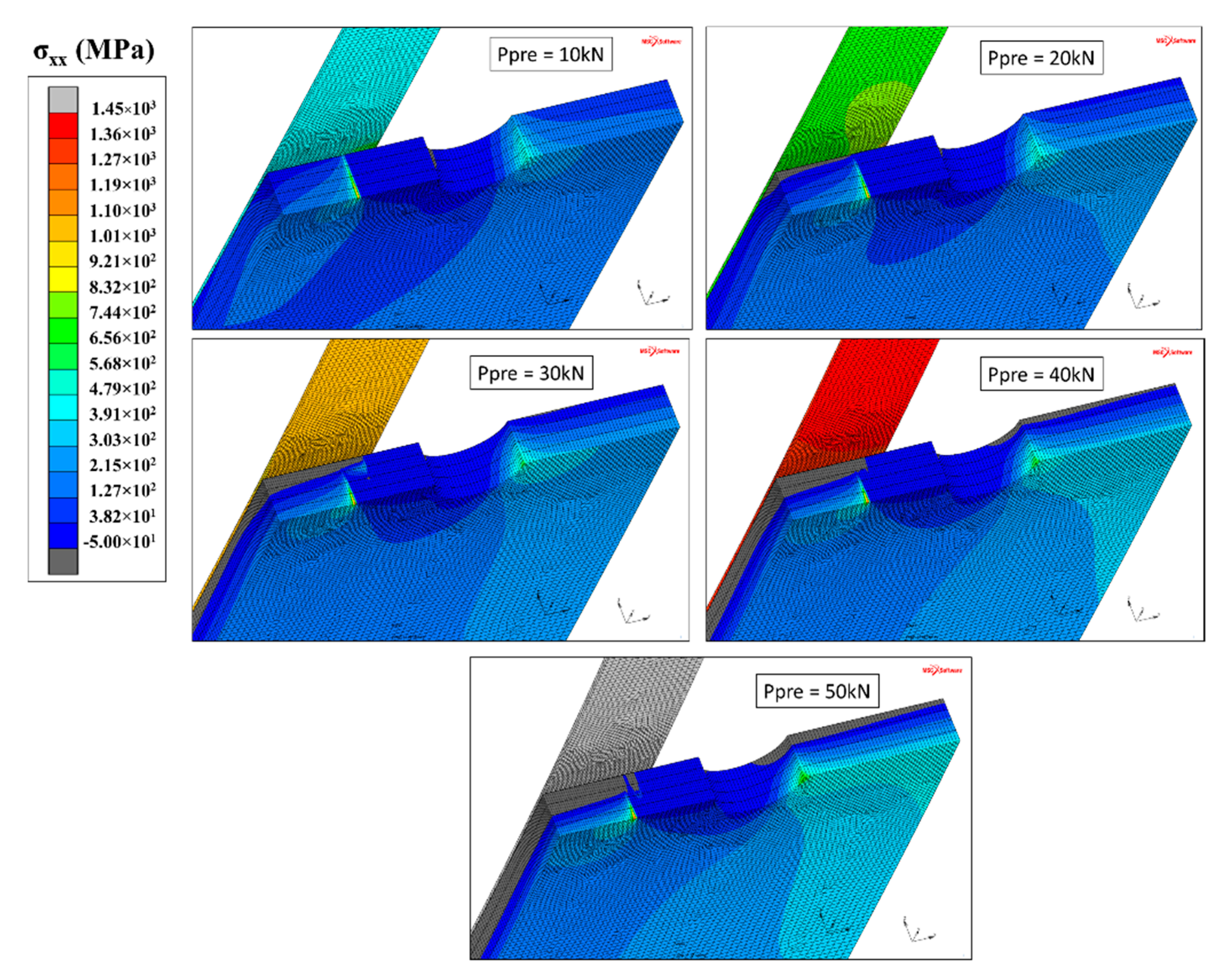
| Material Properties | S235 Carbon Steel | NM CFRP Laminate | UHM CFRP Laminate | Adhesive A | Adhesive B |
|---|---|---|---|---|---|
| Tensile strength (MPa) | 506 (3.40) | - | - | 21.4 (2.96) | 29.5 (0.75) |
| Yield strength (MPa) | 250 (14.50) | - | - | - | - |
| Modulus (MPa) | 197,000 (2100) | 165,000 | 460,000 | 3650 (290) | 2400 (56) |
| Thickness (mm) | 10 | 1.2 | 2.3 | 0.5 | 0.5 |
| Material | |||||||
|---|---|---|---|---|---|---|---|
| Steel plate | 200,000 | - | 0.3 | - | - | - | - |
| NM CFRP laminate | 165,000 | 9100 | 0.3 | 0 | 0.017 | 3400 | 4600 |
| Adhesive A | 3650 | - | 0.3 | - | - | - | - |
| UHM CFRP laminate | 460,000 | 9900 | 0.3 | 0 | 0.006 | 3700 | 5100 |
| Adhesive B | 2400 | - | 0.3 | - | - | - | - |
| Specimen | Specimen Number | Fatigue Life (Cycles) | Fatigue Life Increase Ratio | Average Fatigue Life Increase Ratio |
|---|---|---|---|---|
| S_R (S235 carbon steel reference specimens) | 1 | 429,798 | - | - |
| 2 | 403,639 | |||
| S_NM_NP_SS | 1 | 487,675 | 1.17 | 1.27 (0.064) |
| 2 | 564,600 | 1.35 | ||
| 3 | 533,086 | 1.28 | ||
| S_NM_P(10kN)_SS | 1 | 770,000 | 1.85 | 1.74 (0.105) |
| 2 | 681,902 | 1.64 | ||
| S_NM_NP_DS | 1 | 1,080,215 | 2.59 | 2.27 (0.170) |
| 2 | 902,460 | 2.17 | ||
| 3 | 958,183 | 2.3 | ||
| 4 | 849,870 | 2.04 | ||
| S_UHM_NP_SS | 1 | 765,611 | 1.84 | 2.18 (0.227) |
| 2 | 1,013,660 | 2.43 | ||
| 3 | 944,594 | 2.27 |
Publisher’s Note: MDPI stays neutral with regard to jurisdictional claims in published maps and institutional affiliations. |
© 2021 by the authors. Licensee MDPI, Basel, Switzerland. This article is an open access article distributed under the terms and conditions of the Creative Commons Attribution (CC BY) license (http://creativecommons.org/licenses/by/4.0/).
Share and Cite
Lepretre, E.; Chataigner, S.; Dieng, L.; Gaillet, L. Stress Intensity Factor Assessment for the Reinforcement of Cracked Steel Plates Using Prestressed or Non-Prestressed Adhesively Bonded CFRP. Materials 2021, 14, 1625. https://doi.org/10.3390/ma14071625
Lepretre E, Chataigner S, Dieng L, Gaillet L. Stress Intensity Factor Assessment for the Reinforcement of Cracked Steel Plates Using Prestressed or Non-Prestressed Adhesively Bonded CFRP. Materials. 2021; 14(7):1625. https://doi.org/10.3390/ma14071625
Chicago/Turabian StyleLepretre, Emilie, Sylvain Chataigner, Lamine Dieng, and Laurent Gaillet. 2021. "Stress Intensity Factor Assessment for the Reinforcement of Cracked Steel Plates Using Prestressed or Non-Prestressed Adhesively Bonded CFRP" Materials 14, no. 7: 1625. https://doi.org/10.3390/ma14071625
APA StyleLepretre, E., Chataigner, S., Dieng, L., & Gaillet, L. (2021). Stress Intensity Factor Assessment for the Reinforcement of Cracked Steel Plates Using Prestressed or Non-Prestressed Adhesively Bonded CFRP. Materials, 14(7), 1625. https://doi.org/10.3390/ma14071625








